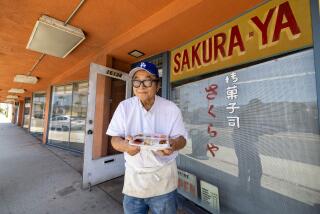U.S. Marketing Tool : Ink Leaves a Big Imprint on Japan
The maquiladora handbook distributed last week by Mark 8, a San Diego-based marketing and consulting company, contains few surprises.
The glossy, four-color publicationâs cover emphasizes the growing interdependence of Japan, Mexico and the United States. It includes what one contributor described as âthe nitty-gritty of what you need to knowâ about establishing maquiladoras, the plants that manufacturing companies set up in Mexico to take advantage of lower wages.
And the 130-page publicationâs advertisers include major developers, office supply stores, financial institutions and consulting firms that hope to benefit from the rapidly growing movement that has already produced 350 maquiladoras in the Tijuana region.
But Mark 8âs publication does have an important distinguishing characteristic: It is written in Japanese, and most of its 10,000 copies will be distributed to high-level business executives in Japan.
Important Marketing and Advertising Tools
Also, Time Inc. will include a 20-page advertising supplement based on the book in its Japanese-language magazine, President, which circulates to executives in that country.
Hyde previously published Subarashi San Diego, a Japanese-language publication that translates as âWonderful San Diego.â The San Diego Economic Development Corp. distributes that magazine-style publication to Japanese visitors who want general information about San Diego County.
Japanese-language publications such as Subarashi and the maquiladora handbook have become important marketing and advertising tools for U.S.-based companies and organizations with a message for Japanese business executives, according to experts.
âEven though the Japaneseâs familiarity with English is vastly superior than (this nationâs) understanding of Japanese, there are millions of Japanese who are not fluent in English,â according to Peter Gourevitch, dean of UC San Diegoâs Graduate School of International Relations and Pacific Studies.
âThe Japanese have to have printed materials before theyâll start making decisions,â said Ellen Cook, an associate professor of international business at the University of San Diego. âThe executives at the top of the middle-management level take those materials and share the relevant partsâ with executives elsewhere in the company.
Cook used a Japanese-language video and printed materials during the early 1970s when she was marketing a Dallas-based world trade center.
âAt the time, the Japanese were not very familiar with Dallas (because) they knew it as a tourist destination rather than a place to do business,â she said.
Japanese-language materials were âdefinitely the way to go with the Japanese because they seem to especially need printed materials,â Cook said. âThey want something to take away from the discussion to circulate among their group.â
But companies should be careful about how they present information in printed form, according to Cook and Gourevitch, because a shoddy document can wreck a potential business venture.
âIn Japan, information is very important,â according to Gourevitch. âA printed document gives them information about what a potential client is like.â Consequently, Japanese business people will âbe impressed with someone who has taken the time to develop a (high-class) Japanese publication.â
UCSDâs graduate school last year translated one of its admissions brochures into Japanese in order to make it easier to recruit Japanese students. And graduate students in the universityâs international relations program are being taught about the importance that Japanese business executives place on Japanese-language materials.
The San Diego EDC has for several years used different Japanese-language publications to âhand to Japanese clients as they come into our offices,â according to EDC Vice President Paul Devermann.
Tremendous Information Problems
The EDC has published a Japanese-language version of a San Diego âfact book,â and it recently translated last Novemberâs Forbes magazine advertising supplement. That supplement will be mailed to Japanese business executives, Devermann said.
The maquiladora publication probably will be well-received in Japan because âthe maquiladora phenomenon is happening so fast that people in Minneapolis are having a hard time keeping track of whatâs happening,â Gourevitch said.
âItâs a complicated thing, and there are tremendous information problemsâ when it comes to what a maquiladora is and how you set one up, he said.
In a related development, the EDC recently published a fairly comprehensive list of the 150 largest maquiladoras in Tijuana. Mexican officials believe there are as many as 350 maquiladoras in Tijuana, but, according to Devermann, the 150 largest probably account for about 80% of the action.
The EDC published the listing because âwe feel thereâs a good opportunity for (San Diego-based) suppliers to be selling to those plants,â he said. âAnd we get so many questions from individuals and corporations that we thought this would be a good way to let people know whatâs going on down there.â
More to Read
Inside the business of entertainment
The Wide Shot brings you news, analysis and insights on everything from streaming wars to production â and what it all means for the future.
You may occasionally receive promotional content from the Los Angeles Times.










